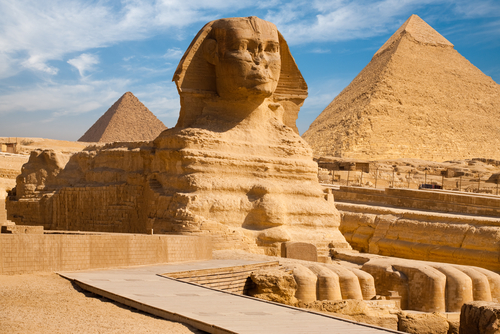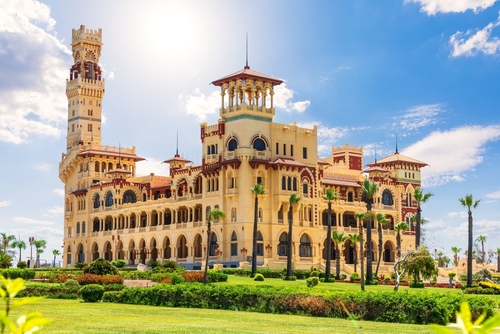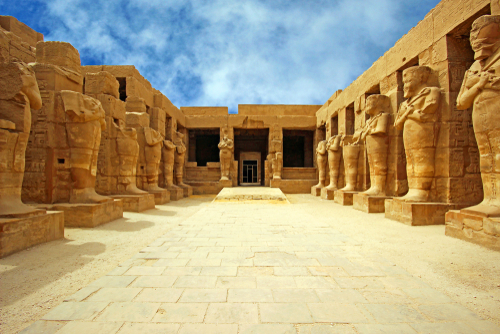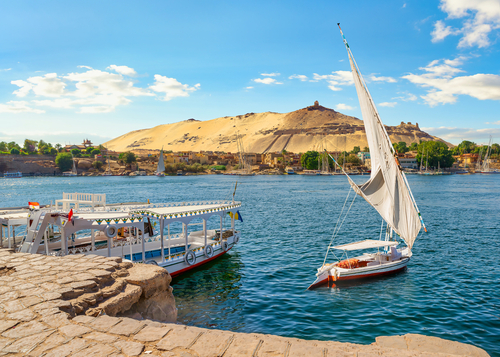They say that to journey through Egypt is to be as close as you can to time travel. As you stroll through the perfectly preserved ancient cities, you are walking among our oldest and earliest civilizations. This remarkable country is home to some of the world’s best-preserved ancient temples and tombs. Egypt is famous for its breathtaking scenery and a community of people whose customs and cultures have evolved over thousands of years alongside the majestic Nile.
There’s always more to see and do when you visit Egypt. And after your scheduled days here are over, there’s always a plan to come back and explore that ‘more’ that you’ve yet to see. If it’s your first time visiting Egypt, you might not have many days to take your time and slow travel. And while it’s hard to truly get the full experience of the country in a week or less, it’s not impossible. If your travel itinerary to Egypt is only 7 days long, you can follow this travel plan that includes the best sights and experiences this ancient country has to offer.
You’ll get to see Egypt’s most iconic and well-preserved sites, including the Great Pyramid of Giza, the remarkable Sphinx, the ancient bazaar, the Saqqara Step Pyramid, the Roman Amphitheater, the legendary City of Memphis, the Unfinished Obelisk, and more. We’ve also included a coastal travel plan that includes sail tours to immerse you in the dramatic and timeless landscapes of the Nile River.
Read more: 5 Reasons Why You Will Fall in Love with Cairo
7 Days in Egypt: The Best Travel Itinerary for Exploring Egypt
Table of Contents
Toggle
Egypt is brimming with ancient sights to explore, landscapes to marvel at, and a culture to study further. From the Egyptian Museum to the Philae Temple and the Roman Amphitheater to the Qaitbay Castle, this Egypt travel itinerary includes Cairo, Giza, Aswan, Luxor, and Alexandria as the main destinations.
One Week Egypt Travel Itinerary
Day 1: Cairo

Cairo is Egypt’s capital and one of the world’s most densely populated cities, with a bustling ambiance and a vibrant hub of the local culture. Spending a day in Cairo will have you learning about Egypt’s colorful culture and traditions, as they date back to ancient times.
How to Spend a Day in Cairo?
Spend an incredible first day in Cairo by exploring the museums, bazaars, and local sites.
Egyptian Museum: This museum is home to an exceptional collection of over 120,000 ancient artifacts dating back over 3,500 years. It’s easy to spend hours immersed in the relics of bygone times.
Salah El-Din Citadel: This citadel dates back to 1176, when it served as the capital until 1860. In the citadel, you can also visit the stunning Mohamed Ali Mosque or Alabaster Mosque.
The National Museum of Egypt: Located in El Fustat, the first capital of Egypt during the early Islamic era. The National Museum of Egyptian Civilization (NMEC) is situated in the heart of the old Cairo city with ancient artifacts dating back to 4,500 years.
El Khalili Bazaar: Get a taste of the local Cairo culture with bargaining and bickering over prices here in El Khalili Bazaar. Built in 970 A.D., the Fatimid dynasty constructed it beside the metropolis of Cairo.
Check out: Cairo, Alexandria, and Aswan Package (6 Days)
Day 2: Giza

Giza is a city in Egypt on the west bank of the Nile, near Cairo. Known for its famous Egyptian buildings, the Giza Plateau is home to three towering pyramids that were constructed as royal mausoleums in the 26th century B.C.
How to Spend a Day in Giza?
Giza Pyramid Complex: The Giza pyramid complex dates to 2400 B.C.. It includes the three great pyramids (Menkaure, Khafre, and Cheops), the Sphinx, and the valley temple. One of the structures located on the plateau is King Khufu’s “Great Pyramid.”
The Magical Sphinx: The Great Sphinx, also known as the Magical Sphinx, is said to be one of the earliest monuments in Egyptian history. It was constructed to protect the complex.
The Valley Temple: The Valley Temple is the famous site where the mummification process was conducted for the kings and queens.
Saqqara Step Pyramid: This was one of the first pyramids ever built in Egypt, around 2700 BC. This structure kicked off everything revolving around the golden age of pyramid construction in Ancient Egypt.
City of Memphis: Memphis was the first recognized capital of Ancient Egypt under the direction of its founder, King Menes. The city served as the center for government, commerce, and the arts under the ruler Ptah.
Check out: Cairo and Aswan Package (4 Days)
Day 3: Alexandria

Alexandria is Egypt’s port city on the Mediterranean. It had a famous library and a lighthouse that was one of the Seven Wonders of the Ancient World during the Hellenistic era.
How to Spend a Day in Alexandria?
National Museum of Alexandria: Constructed in 1926, the museum occupies the palace of Governor Al-Saad Bassili. It is a white Italianate palace that served as the social hub for Alexandria’s upper-class Egyptians.
The Library of Alexandria: Reconstructed in 1987 as a tribute to the old library, this site serves as a still-standing reminder of the old epicenter of learning and culture.
Site of Kom the Dekka: This is an archaeological site of a Greco-Roman residential complex. This neighborhood’s components include the baths, the cisterns, a few villas, and even a tiny amphitheatre.
Pompey’s Column: This was the location of the Serapeus Temple, a shrine dedicated to the worship of Serapis. Serapis was a Greco-Egyptian god who was designated by Ptolemy I as the official god of Egypt and Greece and the patron of Alexandria.
Qaitbay Citadel: Built in the fifteenth century, Quality Citadel is a defensive fortress—quite new as compared to all the other monuments in Alexandria. It is situated at the port on the island of Faro.
Check out: Alexandria, Luxor & Cairo Package (7 Days)
Day 4: Luxor

The city of Luxor is located in southern Egypt on the east bank of the Nile River. It stands on the site of ancient Thebes, the capital city of the Pharaohs from the sixteenth to the eleventh century B.C.
How to Spend a Day in Luxor?
Karnak Temple: This temple complex was the most important religious complex in ancient Egypt. It was the biggest temple in the country, having grown larger throughout time as several pharaohs constructed additional structures and minor temples dedicated to other deities.
Luxor Temple: The temple was erected in honor of Amun-Ra, the deity of the sun, the sky, and the beginning of life. Similar to the Karnak temple, the Luxor temple is composed of structures erected in honor of several deities from various eras.
The Valley of the Kings: The Valley of the Kings is a vast valley sandwiched between two mountains that are lined with rock-cut tombs. During the New Kingdom, when Egypt’s capital was Thebes (now Luxor), this used to be the burial ground for the pharaohs.
Temple of Hatshepsut: This temple honors Hatshepsut, the first woman to rule ancient Egypt alone for 21 years, and is split into three levels. The Hatshepsut Mortuary Temple is surrounded by mountains and is a well-enduring stone structure.
The Colossi of Memnon: The Colossi of Memnon are two enormous stone sculptures that depict Pharaoh Amenhotep III sitting and gazing out at the Nile River with his hands resting on his knees.
Check out: Luxor and Aswan Package (4 Days)
Day 5 and 6: Aswan

Aswan is a city on the Nile River that has served as the strategic and commercial entry point for southern Egypt since the old days. It is home to important archaeological monuments such as the Philae Temple complex, which is located on Agilkia Island close to the famous Aswan Dam.
How to Spend a Day in Aswan?
Philae Temple: Located in the center of the island, the complex is a Ptolemaic temple devoted to the goddess Isis. The Philae Complex is surrounded by smaller structures constructed at varying eras by different pharaohs, making its exact dating impossible to ascertain.
The Temple of Abu Simbel: During the time of Ramses II (1279–1213 BC), two ancient Egyptian temples were cut out of the rock on the west bank of the Nile to form the complex known as the Temple of Abu Simbel. Abu Simbel is well-known for its enormous sculptures of Ramses II and Nefertari.
The Unfinished Obelisk: This obelisk was constructed in the 18th dynasty under Hatshepsut’s rule, but it was eventually abandoned before it could be completed. It is regarded as the oldest obelisk from prehistoric Egypt. The obelisk now stands as an outdoor museum.
The Aswan Museum: The Aswan Museum is located southeast of Elephantine Island and was opened to the public in 1912. This museum displays antiquities salvaged from the flooding of the Nile with the construction of the Aswan Low Dam. It features displays depicting the city’s everyday life and cultural and religious growth throughout the ages.
The Monastery of San Simeon: The monastery dates back to the end of the 6th or early 7th century, housing a thousand monks in the tenth century.
Necropolis of Qubbet Al Hawa: Qubbet Al Hawa is a 130-meter-high rock mountain located in front of the contemporary city. There are eighty rows of aristocrats’ graves on this mountain that date from the Greco-Roman, Old Kingdom, Middle Kingdom, and New Kingdom periods.
Nubian Village: The Nubian Village is home to the native Nubian people, who are renowned for their architecture, history, rituals, traditions, and even their style of life, which combines beautiful, colorful settings with unique clothing.
The Nubian Museum: The Nubian Museum was created by architect Muhammad Al-Hakim and opened to the public in 1998. It is a structure housing a 5,000-piece collection depicting Nubia’s history and culture, with a few monuments that were preserved from the Nile’s flooding during the completion of the High Dam.
Check out: Cairo, Luxor, and Aswan Package (6 Days)
Day 7: Nile Cruise
For your last day in Egypt, spend it in the most unforgettable way with a Nile cruise tour. You’ll take a trip down the Nile River to Luxor on your last day, making stops along the route to visit the temples at Edfu and Luxor. Here you can spend time relaxing in the sun, snorkeling, or having some delicious Middle Eastern cuisine.
You can catch the flight back to Cairo the next day to end your seven days in Egypt.
Read more: Tracing History: Exploring the Historical Wonders of Jordan
Capturing the True Essence of Egypt With Guided Tours
It’s simply impossible to capture the entire essence of Egypt’s travel experience in just a couple of days. This is why travelers keep visiting the country again and again to capture the experiences they might have missed out on their previous trips. However, if you follow a well-planned travel itinerary, you can spend your scheduled days exploring the country’s most iconic destinations without wasting your time asking around for places to visit.
Do you want to explore Egypt’s rich heritage and beauty on a budget? All with pre-booked accommodations, guided tours, and the opportunity to skip the lines?
iLinkTurkey offers a diverse range of guided tour packages for destinations in Egypt. Head over to our packages and book one of our featured Egypt packages now.










